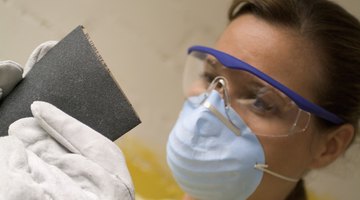How to Paint Over Fake Wood Grain Paneling
Fake wood grain paneling is composed of high-density polyurethane manufactured to provide an cheap alternative to actual wood panels. Unfortunately, unlike actual wood, these panels are slick and nonporous making them poor surfaces for paint adhesion.

If you would like to paint over fake wood grain paneling, you will need to apply a bonding primer, first, or the paint will peel up. In addition, you will need to abrade the surface to promote adhesion before you prime, or the primer will chip away over time.
Things You Will Need
- Dish soap
- Rags
- Heavy-duty fabric drop cloth
- Pal sander
- 300-grit sandpaper
- Blue painter's tape
- 5-gallon bucket
- Roller frame
- Nap roller cover
- 3- to 4-inch latex paint brush
- Latex bonding primer
- Interior acrylic latex paint
Tip
Ensure that all soapy residue has been rinsed, or you may have problems with adhesion. Do not use masking tape in place of painter's tape or paint may bleed underneath.
Warning
Never attempt to paint over fake wood grain paneling without first abrading it with sandpaper or you will have difficulties with primer adhesion.
-
Clean the fake wood grain paneling using soap and wet rags. Rinse away all soapy residue. Allow the surface to dry completely.
-
Cover flooring adjacent to the fake wood paneling with fabric drop cloths. Cover any areas you do not want painted with tape.
-
Abrade the paneling to promote adhesion by sanding it with a palm sander loaded with 300-grit sandpaper.
-
Apply a thin coat of primer to the paneling using the roller. Allow the primer to dry for three hours. Apply primer to any areas of the fake wood grain paneling inaccessible to the roller using the paintbrush.
-
Apply two thin coats of interior acrylic latex paint to the paneling in the same way you did the primer. Allow two hours of dry time between coats.
The Drip Cap
- Fake wood grain paneling is composed of high-density polyurethane manufactured to provide an cheap alternative to actual wood panels.
- Unfortunately, unlike actual wood, these panels are slick and nonporous making them poor surfaces for paint adhesion.
- Allow the surface to dry completely.
- Apply a thin coat of primer to the paneling using the roller.
Resources
Writer Bio
Ryan Lawrence is a freelance writer based in Boulder, Colorado. He has been writing professionally since 1999. He has 10 years of experience as a professional painting contractor. Lawrence writes for High Class Blogs and Yodle. He has a bachelor's degree in journalism and public relations with a minor in history from the University of Oklahoma.
Photo Credits
- Medioimages/Photodisc/Photodisc/Getty Images
- Medioimages/Photodisc/Photodisc/Getty Images
More Articles



